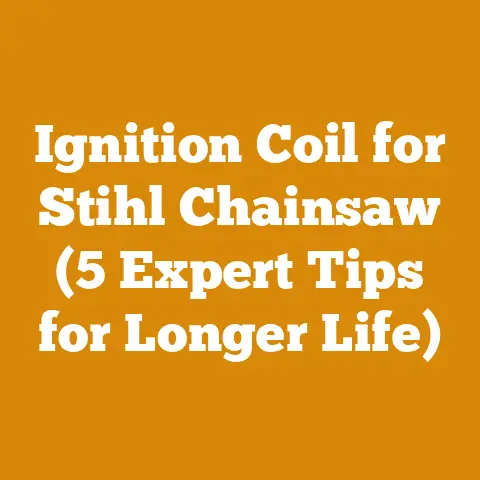Brush Tree Killer: Top Herbicides for Tough Woody Brush (Pro Tips)
Brush Tree Killer: Top Herbicides for Tough Woody Brush (Pro Tips)
Over the years, I’ve dealt with everything from stubborn honeysuckle to resilient buckthorn. Trust me, not all herbicides are created equal. This guide will walk you through understanding different types of herbicides, identifying your target species, and applying the products safely and effectively. Let’s get started!
Understanding Brush Tree and Weed Control
Before you even think about spraying, it’s crucial to understand what you’re up against. “Brush tree” is a broad term encompassing various woody plants, including shrubs, saplings, and even small trees that you don’t want growing in a particular area. Effective brush control isn’t just about killing the visible plant; it’s about preventing regrowth.
-
Identifying Your Enemy: Accurate identification is paramount. Is it a native species you might want to preserve? Or an invasive species like Japanese knotweed that needs to be eradicated? Knowing the specific plant allows you to choose the most effective herbicide.
- Example: Mistaking a dogwood sapling for an invasive maple can lead to unnecessary herbicide use and damage to desirable plants.
-
Understanding Herbicide Types: Herbicides fall into two main categories: selective and non-selective.
-
Selective Herbicides: These target specific plant types while leaving others unharmed. They are ideal for situations where you want to preserve grass or other desirable vegetation.
- Non-Selective Herbicides: These kill all plants they contact. Use them carefully in areas where you don’t mind a complete clear-out.
-
Systemic vs. Contact Herbicides: This is another crucial distinction.
-
Systemic Herbicides: These are absorbed by the plant and transported throughout its system, killing the roots as well as the foliage. They’re generally more effective for woody brush because they prevent regrowth.
- Contact Herbicides: These only kill the parts of the plant they directly touch. They’re better suited for annual weeds and foliage control, but less effective on tough woody brush.
Takeaway: Proper identification and herbicide selection are the foundation of effective brush control.
Top Herbicide Ingredients for Woody Brush
Okay, let’s get down to the nitty-gritty. Several active ingredients are particularly effective against woody brush. These are the workhorses you’ll find in many commercial brush killers. Over the years, I have found these to be the most effective for my wood processing projects.
-
Triclopyr: This is my go-to herbicide for tough woody plants. It’s a systemic herbicide that’s particularly effective on broadleaf weeds and brush. Triclopyr works by disrupting the plant’s growth hormones, leading to its eventual death.
- Application Tips: Triclopyr can be applied as a foliar spray, basal bark treatment, or cut-stump treatment. I’ve found that basal bark treatments are particularly effective for controlling small trees and shrubs.
- My Experience: I once used triclopyr to clear a dense thicket of multiflora rose. Within a few weeks, the roses began to wilt and die back, and they haven’t returned since.
-
Glyphosate: While glyphosate is a non-selective herbicide, it’s still a valuable tool for brush control, especially when used carefully. It works by inhibiting an enzyme essential for plant growth.
-
Application Tips: Glyphosate is most effective when applied to actively growing plants. Avoid spraying on windy days to prevent drift.
- Caution: Glyphosate will kill any plant it touches, so protect desirable vegetation. I’ve accidentally killed a few prized azaleas by being careless with my spray wand.
-
Imazapyr: This is a more potent herbicide that’s effective on a wide range of woody and herbaceous plants. It works by inhibiting the production of certain amino acids necessary for plant growth.
-
Application Tips: Imazapyr has a longer residual activity than triclopyr or glyphosate, meaning it can prevent regrowth for an extended period. However, this also means it can potentially harm desirable plants if it leaches into the soil.
- Important Note: Use imazapyr with caution, especially near water sources or desirable trees. Always follow label instructions carefully.
-
2,4-D: This is a selective herbicide that’s primarily used to control broadleaf weeds. It’s often combined with other herbicides, like triclopyr, to broaden the spectrum of control.
-
Application Tips: 2,4-D is most effective when applied to young, actively growing weeds. Avoid spraying on windy days, as it can drift and damage desirable plants.
- My Experience: I’ve used 2,4-D to control dandelions and other broadleaf weeds in my lawn, with good results. However, it’s not as effective on tough woody brush as triclopyr or imazapyr.
Takeaway: Understanding the strengths and weaknesses of different herbicide ingredients allows you to choose the right tool for the job.
Choosing the Right Herbicide for Your Specific Brush
Now that you know the key herbicide ingredients, let’s talk about matching them to specific brush types. Different species respond differently to herbicides, so it’s essential to choose the right product for your target.
- Honeysuckle: Triclopyr and glyphosate are both effective on honeysuckle. For larger infestations, I recommend a foliar spray of triclopyr. For smaller infestations, you can use a cut-stump treatment of glyphosate.
- Buckthorn: Triclopyr is the herbicide of choice for buckthorn. A basal bark treatment is particularly effective, as it allows the herbicide to be absorbed through the bark and transported to the roots.
- Poison Ivy: Glyphosate is very effective on poison ivy. Be sure to wear protective clothing when spraying, as even dead poison ivy can still cause a rash.
- Multiflora Rose: Triclopyr is the best option for multiflora rose. A foliar spray or basal bark treatment will provide effective control.
- Tree Saplings (Maple, Oak, Ash): For tree saplings, a cut-stump treatment of glyphosate or triclopyr is often the most effective method. Cut the sapling close to the ground and immediately apply the herbicide to the freshly cut surface.
Takeaway: Consider the specific brush species you’re targeting when choosing an herbicide.
Application Methods: Pro Techniques for Success
Choosing the right herbicide is only half the battle. Proper application is just as important. Here are some pro techniques I’ve learned over the years.
-
Foliar Spray: This involves spraying the herbicide directly onto the leaves of the plant. It’s most effective on actively growing plants with plenty of foliage.
- Equipment: Use a backpack sprayer or a handheld sprayer, depending on the size of the area you’re treating.
- Technique: Spray the leaves thoroughly, but avoid runoff. It’s better to apply multiple light coats than one heavy coat.
- Weather Conditions: Avoid spraying on windy days, as the herbicide can drift and damage desirable plants. Also, avoid spraying when rain is expected, as the herbicide can be washed away.
-
Basal Bark Treatment: This involves applying the herbicide to the lower portion of the trunk of a tree or shrub. It’s particularly effective for controlling small trees and shrubs with thin bark.
-
Equipment: Use a low-pressure sprayer with a narrow nozzle.
- Technique: Spray the lower 12-18 inches of the trunk, making sure to thoroughly wet the bark.
- Herbicide Concentration: Use a higher concentration of herbicide for basal bark treatments than for foliar sprays.
-
Cut-Stump Treatment: This involves cutting the tree or shrub close to the ground and immediately applying the herbicide to the freshly cut surface. It’s effective for controlling larger trees and shrubs.
-
Equipment: Use a chainsaw or hand saw to cut the tree or shrub. Use a paintbrush or a small sprayer to apply the herbicide.
- Technique: Apply the herbicide to the entire cut surface, including the cambium layer (the layer just beneath the bark).
- Timing: Apply the herbicide as soon as possible after cutting the tree or shrub. The longer you wait, the less effective the treatment will be.
-
Soil Application: Some herbicides can be applied directly to the soil. This is most effective for controlling weeds and brush that emerge from seeds or rhizomes.
-
Equipment: Use a granular spreader or a liquid sprayer.
- Technique: Apply the herbicide evenly to the soil surface. Avoid applying too much herbicide in one area, as this can damage desirable plants.
- Weather Conditions: Apply the herbicide when rain is expected, as this will help to incorporate it into the soil.
Takeaway: Choose the application method that’s best suited for the type of brush you’re controlling and the size of the area you’re treating.
Safety First: Protecting Yourself and the Environment
Herbicides are powerful tools, but they can also be dangerous if not used properly. Safety should always be your top priority. I’ve seen too many people get careless with chemicals, and the consequences can be severe.
- Read the Label: This is the most important safety tip. Always read and follow the label instructions carefully. The label contains important information about the herbicide’s active ingredients, application rates, safety precautions, and environmental hazards.
- Wear Protective Clothing: Always wear protective clothing when handling herbicides, including gloves, long sleeves, long pants, and eye protection. A respirator may also be necessary, depending on the herbicide and the application method.
- Mix Herbicides Carefully: Mix herbicides in a well-ventilated area. Avoid splashing or spilling the herbicide. Use a dedicated container for mixing herbicides, and never use the same container for other purposes.
- Apply Herbicides Safely: Apply herbicides only when the weather is calm and dry. Avoid spraying on windy days, as the herbicide can drift and damage desirable plants. Also, avoid spraying when rain is expected, as the herbicide can be washed away.
- Store Herbicides Properly: Store herbicides in a cool, dry place, out of reach of children and pets. Keep herbicides in their original containers, and never transfer them to unmarked containers.
- Dispose of Herbicides Properly: Dispose of unused herbicides and empty containers according to label instructions. Never pour herbicides down the drain or into the environment.
Takeaway: Always prioritize safety when handling herbicides. Read the label, wear protective clothing, and follow all safety precautions.
Timing is Everything: When to Apply Brush Killers
The timing of your herbicide application can significantly impact its effectiveness. I’ve learned this the hard way, applying herbicides at the wrong time and seeing minimal results.
- Active Growth: Herbicides are most effective when applied to actively growing plants. This is because the plants are actively absorbing nutrients and water, which helps to transport the herbicide throughout their system.
- Foliar Applications: For foliar applications, the best time to apply herbicides is in the spring or early summer, when the plants are actively growing and have plenty of foliage.
- Basal Bark Treatments: Basal bark treatments can be applied any time of year, but they are most effective in the late fall or early winter, when the plants are dormant.
- Cut-Stump Treatments: Cut-stump treatments should be applied immediately after cutting the tree or shrub. The longer you wait, the less effective the treatment will be.
- Avoid Stress: Avoid applying herbicides when plants are stressed due to drought, heat, or disease. Stressed plants are less likely to absorb the herbicide, which can reduce its effectiveness.
Takeaway: Time your herbicide applications to coincide with the plant’s active growth cycle for optimal results.
Troubleshooting Common Problems
Even with the best planning, things can sometimes go wrong. Here are some common problems you might encounter and how to troubleshoot them.
- Herbicide Not Working: If your herbicide isn’t working, the first thing to do is check the label to make sure you’re using the right product for the type of brush you’re controlling. Also, make sure you’re using the correct application rate and method. If you’re still having problems, try reapplying the herbicide after a few weeks.
- Damage to Desirable Plants: If you accidentally spray desirable plants with herbicide, immediately wash them off with water. Prune any damaged foliage. To prevent future problems, be more careful when applying herbicides, and use a shield to protect desirable plants.
- Herbicide Drift: Herbicide drift can occur when the wind carries the herbicide to unintended areas. To prevent drift, avoid spraying on windy days. Also, use a low-pressure sprayer and a coarse nozzle to reduce the amount of fine mist produced.
- Soil Contamination: Herbicides can contaminate the soil if they are applied improperly or if they leach into the soil from treated plants. To prevent soil contamination, follow label instructions carefully, and avoid applying too much herbicide in one area.
Takeaway: Be prepared to troubleshoot common problems and adjust your approach as needed.
Long-Term Brush Management Strategies
Brush control is rarely a one-time event. It’s an ongoing process that requires a long-term management strategy. I’ve learned that consistent effort is key to keeping unwanted brush at bay.
- Prevention: The best way to control brush is to prevent it from becoming established in the first place. This can be done by maintaining healthy vegetation, controlling erosion, and promptly removing any new brush seedlings.
- Regular Monitoring: Regularly monitor your property for new brush growth. The sooner you catch it, the easier it will be to control.
- Integrated Pest Management (IPM): IPM is a holistic approach to pest management that combines various control methods, including cultural practices, biological controls, and chemical controls. By using a combination of methods, you can minimize your reliance on herbicides and reduce the risk of environmental damage.
- Cultural Practices: Cultural practices, such as mowing, grazing, and prescribed burning, can help to control brush. Mowing can prevent brush from becoming established, while grazing can help to control existing brush. Prescribed burning can be used to kill brush and promote the growth of desirable vegetation.
- Biological Controls: Biological controls, such as insects and pathogens, can also be used to control brush. For example, certain insects feed on specific types of brush, helping to keep them in check.
- Chemical Controls: Herbicides should be used as part of an integrated pest management strategy, not as the sole control method. Use herbicides selectively and only when necessary.
Takeaway: Develop a long-term brush management strategy that combines prevention, monitoring, and various control methods.
Case Studies: Real-World Brush Control Successes
Let me share a few real-world examples of successful brush control projects I’ve been involved in. These case studies highlight the importance of proper planning, herbicide selection, and application techniques.
- Case Study 1: Clearing a Power Line Right-of-Way: A local utility company needed to clear a power line right-of-way that was overgrown with brush. The brush was interfering with the power lines and posing a safety hazard. I recommended a combination of mechanical clearing and herbicide applications. First, we used a forestry mulcher to remove the larger trees and shrubs. Then, we applied a foliar spray of triclopyr to control the remaining brush seedlings and sprouts. The project was completed on time and within budget, and the power line right-of-way has remained clear of brush ever since.
- Case Study 2: Restoring a Native Prairie: A local conservation organization wanted to restore a native prairie that had been invaded by brush. The brush was shading out the native prairie plants and reducing biodiversity. I recommended a combination of prescribed burning and herbicide applications. First, we conducted a prescribed burn to kill the existing brush and stimulate the growth of native prairie plants. Then, we applied a selective herbicide to control any remaining brush seedlings and sprouts. The prairie has been successfully restored, and native prairie plants are thriving.
- Case Study 3: Controlling Invasive Species on a Hiking Trail: A local park district needed to control invasive species, such as Japanese knotweed and honeysuckle, along a popular hiking trail. The invasive species were crowding out native plants and making it difficult for hikers to pass. I recommended a combination of manual removal and herbicide applications. First, we manually removed the larger infestations of invasive species. Then, we applied a cut-stump treatment of glyphosate to control the remaining plants. The hiking trail has been cleared of invasive species, and native plants are recovering.
Takeaway: These case studies demonstrate that successful brush control requires a tailored approach that considers the specific site conditions, target species, and management goals.
The Future of Brush Control: Innovations and Trends
The field of brush control is constantly evolving, with new technologies and techniques emerging all the time. Here are some innovations and trends to watch out for.
- Drone Technology: Drones are being used to survey brush infestations and apply herbicides more efficiently. Drones can cover large areas quickly and accurately, and they can be equipped with GPS technology to target specific areas.
- Precision Herbicide Application: Precision herbicide application involves using sensors and GPS technology to apply herbicides only to the target plants. This minimizes the amount of herbicide used and reduces the risk of environmental damage.
- Biological Herbicides: Biological herbicides are made from natural substances, such as bacteria and fungi, that kill or suppress weeds and brush. Biological herbicides are generally considered to be safer for the environment than synthetic herbicides.
- Integrated Vegetation Management (IVM): IVM is a holistic approach to vegetation management that combines various control methods, including cultural practices, biological controls, and chemical controls. IVM aims to create a sustainable and environmentally sound vegetation management program.
Takeaway: Stay informed about the latest innovations and trends in brush control to improve your management practices and reduce your environmental impact.
Conclusion: Reclaiming Your Land, One Brush at a Time
Brush control can be a challenging task, but with the right knowledge, tools, and techniques, you can successfully reclaim your land from unwanted woody brush. Remember to identify your target species, choose the appropriate herbicide, apply it safely and effectively, and develop a long-term management strategy. By following these tips, you can create a healthy and thriving landscape that you can enjoy for years to come.
And don’t forget, patience is key. Brush control is often an ongoing process, and it may take several years to achieve your desired results. But with consistent effort and a commitment to best practices, you can win the battle against tough woody brush.






